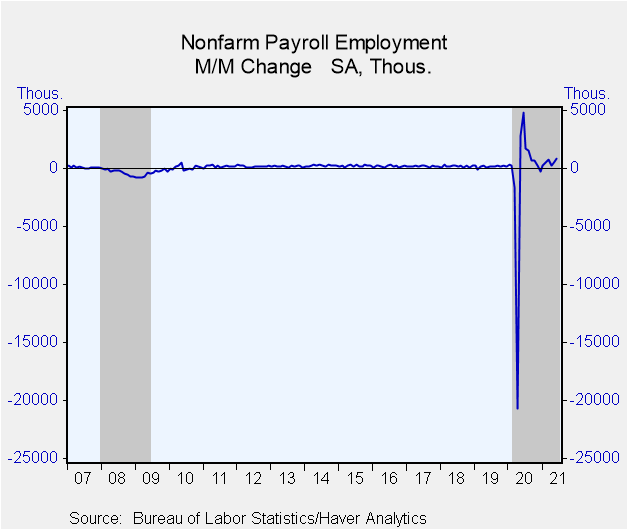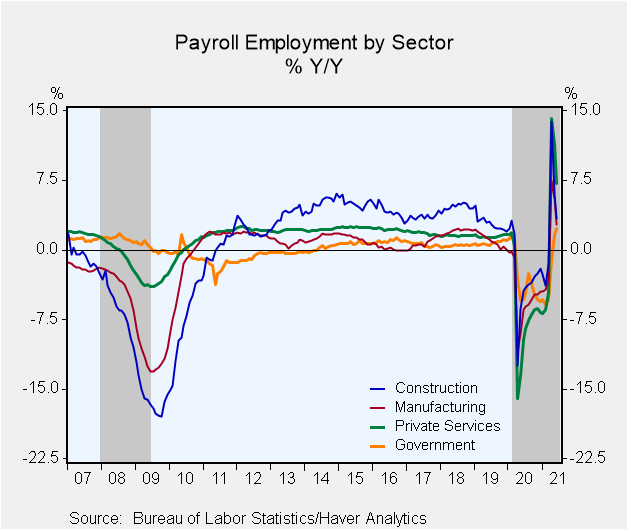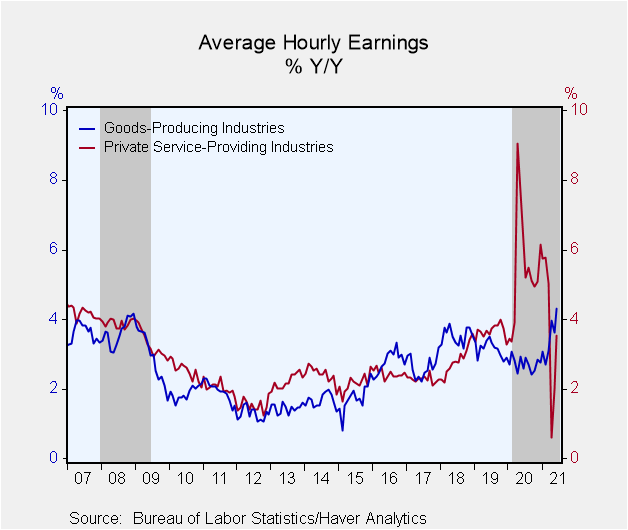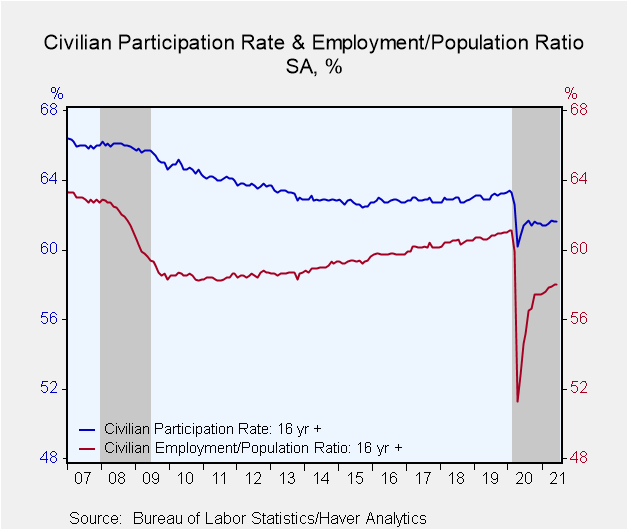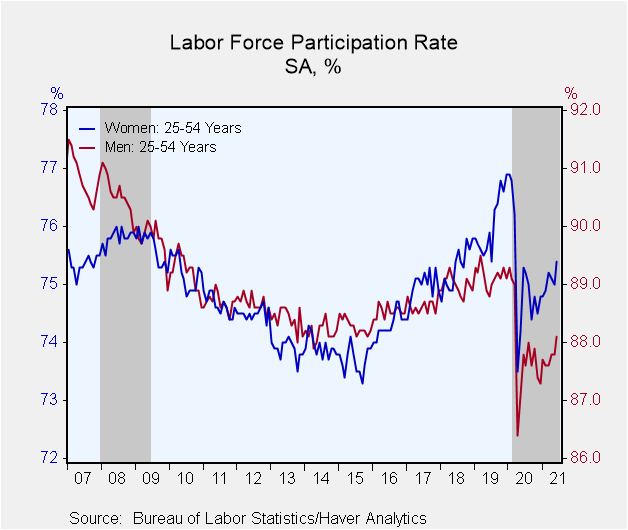 Global| Jul 02 2021
Global| Jul 02 2021U.S. Payroll Strength Exceeds Expectations in June
by:Tom Moeller
|in:Economy in Brief
Summary
• Service-sector gains led by leisure & hospitality. • Average hourly earnings growth moderates. • Unemployment rate edges higher. Nonfarm payroll employment increased 850,000 (5.8% y/y) during June. It was the largest increase since [...]
• Service-sector gains led by leisure & hospitality.
• Average hourly earnings growth moderates.
• Unemployment rate edges higher.
Nonfarm payroll employment increased 850,000 (5.8% y/y) during June. It was the largest increase since August of last year. A 700,000 rise had been expected in the Action Economics Forecast Survey. This gain was accompanied by a modest upward revision to the May increase to 583,000 from 559,000. The April gain was lessened to 269,000 from 278,000.
Average hourly earnings rose 0.3% last month (3.6% y/y) following a 0.4% May rise, revised from 0.5%. A 0.4% increase had been expected.
The unemployment rate ticked higher to 5.9% in May, compared to expectations for a drop to 5.6%. The labor force rose 151,000 after falling 53,000 in May. At the same time, employment in the household survey declined 18,000 after rising 444,000. The overall unemployment rate, including those who were marginally attached or working part-time for economic reasons, fell to 9.8% from 10.2%, the lowest level since March of last year.
The 850,000 increase in payroll jobs was paced by a 343,000 gain in leisure & hospitality, the largest increase in four months. A 99,000 gain in trade, transportation & utilities jobs reflected a 67,100 increase in retail trade, the largest increase since last October. Professional & business services jobs gained 72,000, double the May rise. Education & health services employment improved 59,000 for the second straight month. Information jobs rose 14,000 but financial sector jobs eased 1,000, off for the second straight month.
Factory sector employment rose 15,000, the smallest increase in five months. Construction sector payrolls weakened 7,000, the fourth decline in five months.
Government sector employment rose 188,000. A 124,000 increase in local payrolls reflected a 155,200 rise in education services. The number of state government jobs rose 69,000, also reflecting a 74,500 jump in teachers. Federal government employment fell 5,000.
Average hourly earnings improved 0.3%. Earnings in the leisure & hospitality sector jumped 1.0%, the fourth month of strong increase. Information sector earnings rose 0.5% while education & health sector earnings gained 0.3%. Factory sector pay improved 0.4% after two straight months of 0.6% increase. Construction sector earnings gained 0.3%.
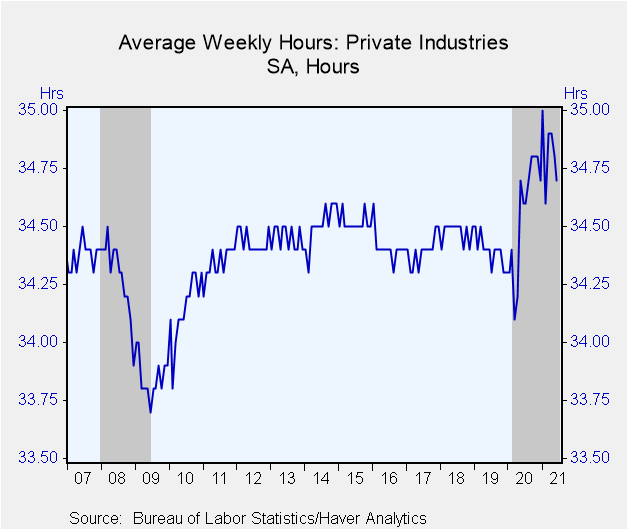 The length of the average workweek eased to 34.7 hours, the
shortest workweek in four months. The financial sector workweek held steady at
37.6 hours but the information sector workweek eased to 37.0 hours. The
education & health services workweek held steady at 33.3 hours and the
leisure & hospitality workweek also was stable at 26.5 hours. The factory
sector workweek declined to 40.2 hours, the shortest workweek in six months. The
construction workweek fell sharply to 38.6 hours from 39.4 hours three months earlier.
The length of the average workweek eased to 34.7 hours, the
shortest workweek in four months. The financial sector workweek held steady at
37.6 hours but the information sector workweek eased to 37.0 hours. The
education & health services workweek held steady at 33.3 hours and the
leisure & hospitality workweek also was stable at 26.5 hours. The factory
sector workweek declined to 40.2 hours, the shortest workweek in six months. The
construction workweek fell sharply to 38.6 hours from 39.4 hours three months earlier.
From the household employment survey, the higher 5.9% unemployment rate in June occurred as the labor force participation rate held steady at 61.6% and remained below the 63.4% high in January of last year. The teenage participation rate fell to 35.4% from 36.8%, but for individuals aged 20-24 it rose to 70.8%, the highest level in six months. For workers aged 25-54, the rate surged to 81.7%, but remained below the January 2020 high of 83.0%. For men aged 25-54, the rate jumped to 88.1%, the highest level since March of last year. For women of that age, the participation rate jumped to 75.4%, also the highest since March of 2020. For workers aged 55 & over, the participation rate held steady at 38.4% and remained below the July 2019 high of 40.5%.
The employment/population ratio for all workers was steady at 58.0% in June and remained well below the February 2020 high of 61.1%. A lessened 22.0 million worked at home because of the coronavirus, down by roughly one-half versus May of last year.
The average duration of unemployment increased to 31.6 weeks, the most since January 2015. The median unemployment duration was 19.8 weeks, the most since June 2012.
The teenage unemployment rate rose slightly to 9.9% but remained below the record 32.1% in April of last year. The rate for workers aged 20-24 declined to 9.1%. For workers aged 25-54, the rate edged higher to 5.5%, but remained down from last April's high of 12.8%. For those over 55, the jobless rate held steady at 4.9%.
By educational attainment, the rate of unemployment of workers without a high school diploma rose to 10.2% from 9.1%, but remained below the 16.4% rate one year ago. High school graduates without any college were 7.0% unemployed last month, down from the April 2020 high of 17.3%. Those with some college but no degree were unemployed at a slightly lower rate of 5.8%, down sharply from the April 2020 peak of 15.0%. College graduates saw their unemployment rate rise to 3.5% last month and remain higher than the 1.9% low in February of last year.
The employment & earnings data are collected from surveys taken each month during the week containing the 12th of the month. The labor market data are contained in Haver's USECON database. Detailed figures are in the EMPL and LABOR databases. The expectations figures are in the AS1REPNA database.
| Employment (SA, M/M Change, 000s) | Jun | May | Apr | Jun Y/Y | 2020 | 2019 | 2018 |
|---|---|---|---|---|---|---|---|
| Payroll Employment | 850 | 583 | 269 | 5.8% | -5.8% | 1.3% | 1.6% |
| Previous Estimate | -- | 559 | 278 | -- | -- | -- | -- |
| Manufacturing | 15 | 39 | -35 | 2.7 | -5.0 | 1.0 | 2.0 |
| Construction | -7 | -22 | -9 | 3.2 | -3.0 | 2.8 | 4.6 |
| Private Service-Producing | 642 | 497 | 267 | 7.1 | -6.6 | 1.4 | 1.5 |
| Government | 188 | 67 | 43 | 2.3 | -3.1 | 0.7 | 0.5 |
| Average Weekly Hours - Private Sector | 34.7 | 34.8 | 34.9 | 34.6 | 34.6 | 34.4 | 34.5 |
| Private Sector Average Hourly Earnings (%) | 0.3 | 0.4 | 0.7 | 3.6 | 4.8 | 3.3 | 3.0 |
| Unemployment Rate (%) | 5.9 | 5.8 | 6.1 | 11.1 | 8.1 | 3.7 | 3.9 |
Tom Moeller
AuthorMore in Author Profile »Prior to joining Haver Analytics in 2000, Mr. Moeller worked as the Economist at Chancellor Capital Management from 1985 to 1999. There, he developed comprehensive economic forecasts and interpreted economic data for equity and fixed income portfolio managers. Also at Chancellor, Mr. Moeller worked as an equity analyst and was responsible for researching and rating companies in the economically sensitive automobile and housing industries for investment in Chancellor’s equity portfolio. Prior to joining Chancellor, Mr. Moeller was an Economist at Citibank from 1979 to 1984. He also analyzed pricing behavior in the metals industry for the Council on Wage and Price Stability in Washington, D.C. In 1999, Mr. Moeller received the award for most accurate forecast from the Forecasters' Club of New York. From 1990 to 1992 he was President of the New York Association for Business Economists. Mr. Moeller earned an M.B.A. in Finance from Fordham University, where he graduated in 1987. He holds a Bachelor of Arts in Economics from George Washington University.


